It makes sense that, in what is universally acknowledged as the worst-ever decade for film, the midpoint of that decade marks its low point. For those of us who lived through and remember 1985, the nostalgia its movies evoke is undeniable, but that doesn’t change the fact that it was an exceptionally crappy year for cinema.
Among other things, 1985 gave us what may be the worst-ever James Bond movie (the downright-vomitous A VIEW TO A KILL) and a number of crummy “science” films (D.A.R.Y.L., EXPLORERS, THE BRIDE, MY SCIENCE PROJECT, CREATOR) that were instantly forgotten. Coming up with 30 worthwhile entries for this Year in Bedlam listing was a challenge, and resulted in a pretty odd grouping of films, with a Steve Guttenberg comedy and a John Badham popcorn movie rubbing shoulders with films by heavyweights like Andrzej Zulawski and Todd Haynes.
As always with my YIB listings, the guiding principle was to highlight underseen and/or underappreciated cinema. That means you won’t find THE GOONIES or BACK TO THE FUTURE profiled here. You will, however, find a number of interesting obscurities, such as…
30. COLLECTOR’S ITEM [aka LA GABBIA; THE TRAP]
Italy’s late Giuseppe Patroni Griffi (1921-2005) was one of the cinema’s unsung madmen. His output includes TIS PITY SHE’S A WHORE (1971) and THE DRIVER’S SEAT (1973), which provided Liz Taylor with her weirdest role ever. It’s too bad that in later years Griffi was reduced to cranking out trashy potboilers like COLLECTOR’S ITEM. Co-scripted by Lucio Fulci, it’s an agreeably perverse drama involving a yuppie (Tony Musante) taken hostage by an old lover (Laura Antonelli) so she can perform perverted acts on him—and things get even wilder when the woman’s equally horny teenage daughter (Blanca Marsillach) gets into the act (unaware of her father’s true identity). There’s at least one “classic” scene (the mother-daughter mutual masturbation session), along with some graphic violence (Fulci’s contribution?) and an overpowering air of unadorned sleaze. Definitely above-average for this type of film, but that ain’t saying much.
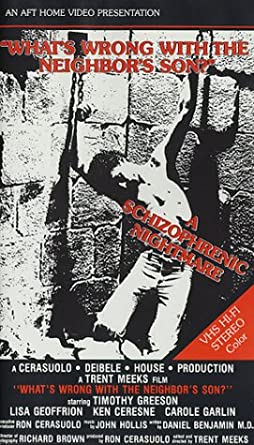 29. WHAT’S WRONG WITH THE NEIGHBOR’S SON?
29. WHAT’S WRONG WITH THE NEIGHBOR’S SON?
A 59-minute oddity that proclaims itself “an astonishing, boldly graphic film revealing the shocking horror that is schizophrenia” with “startlingly realistic visual effects” and “explosive high fidelity stereo sound.” Obviously such claims are false, as an honest-to-goodness budget would be required to accomplish those things. The film is nonetheless an attention-grabber, a near bad movie classic that attempts to function as both a medical documentary and a REPULSION-esque horror fest. Book-ended by onscreen dissertations from real MD’s (“we trust that this docudrama experience has sensitized you to this devastating illness”), it’s the story of a nutcase (Timothy Greeson) who forgets to take his medication one night when his uncaring parents are away and, seeing eyeballs appear in the bathtub and the flesh melting from his arms, trashes his house and strangles his cat. The final scenes, presented for some reason in LA JETEE style, as still frames with voice-over dialogue, have the guy’s ma (Carole Garlin) proclaiming that “with your realization that medication is necessary with the guidance of a caring doctor, we’ll make it…thank God!” FYI, this film was clumsily incorporated into the trashy 1990 SOV-er THE DISTURBANCE, but is best viewed in its original, un-messed-with format.
28. RADIOACTIVE DREAMS
A post-apocalyptic comedy that, as with many of the films of its writer-director Albert Pyun, is more laudable for what it attempts than any actual achievement. Nonetheless, RADIOACTIVE DREAMS has an assured visual style and a quirky nihilism of a type that many similarly themed films (such as HIGHWAY TO HELL and THE BAD BUNCH) have tried, and failed, to capture. Those things partially offset the unevenness of the film, and its lack of anything resembling a cogent narrative (both standard Pyun movie complaints). A large part of the overall problem appears to be that, simply, Pyun’s ambitions far outstripped the non-budget with which he was saddled. But again, the film, about two wannabe private eyes (John Stockwell and Michael Dudikoff) on an aimless jaunt through a morass of monsters and mutants, has an appealing verve and a cheerfully anarchic, anything-goes spirit. Plus the late Lisa Blount makes a sizeable impression in a notably seductive turn as the requisite femme fatale.
27. A MIDSUMMER NIGHT’S DREAM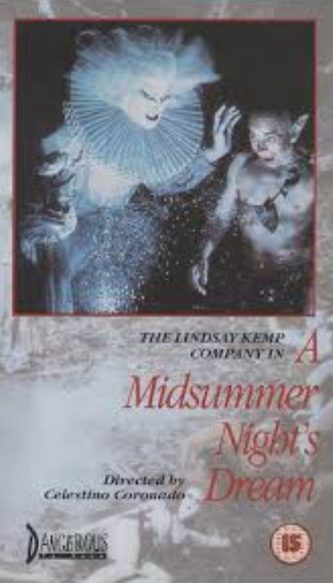
This altogether unique, sexually-tinged theatrical adaptation of the Bard’s immortal classic was put on by the Lindsay Kemp Company, and visualized by director Celestino Coronado (who previously wreaked a similarly quirky number on HAMLET). He does a credible job transposing this patently stage-bound material to film, imparting an authentically dreamy vibe. The setting is an enchanted forest where a cast of frequently nude, sexually androgynous performers enact Shakespeare’s drama, with the dialogue pared down severely and replaced by elaborate dance numbers. The effect is closest to the work of Peter Greenaway (PROPERO’S BOOKS in particular), and like Greenaway’s films this one tends to be a bit monotonous; eye-popping though it is to look at, most every scene looks the same.
26. WINGS OF DEATH
This 21 minute BFI short was paired with A NIGHTMARE ON ELM STREET during its UK theatrical run. It follows a young junkie (Dexter Fletcher) through a nightmarish urban hellscape; he ends up in a seedy hotel room, where he’s overcome with hallucinations and (it seems) dies. The later scenes, which freely utilize stop motion animation (with wallpaper peeling itself from the walls) and hallucinatory flashbacks, are stronger than the earlier ones, which suffer from over lit visuals better suited to a music video. But this haunting and disquieting little film definitely hits its mark.
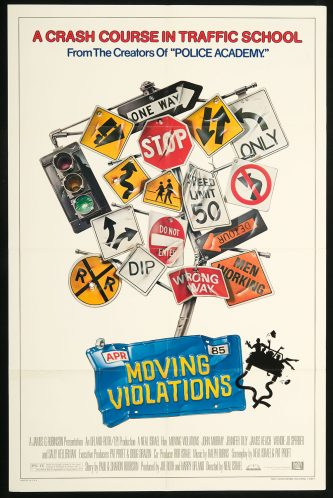 25. MOVING VIOLATIONS
25. MOVING VIOLATIONS
Here’s a surprise: this goofball comedy, which seemed unbearable back in the day (as a Variety reviewer proclaimed, “There’s no excuse for MOVING VIOLATIONS”), has greatly increased in stature. In fact, I’d say it actually outdoes its antecedent, the previous year’s POLICE ACADEMY (which now plays like a student film), in virtually every respect. Directed by the former film’s co-screenwriter Neal Isreal, it’s not dissimilar to Israel’s AMERICATHON in its odd mixture of dystopia and gross out comedy. The setting is a futuristic traffic school run by corrupt cops and comprised of a predictable variety of goofballs. The wise-assed John Murray, Bill’s bro, stars, and is supported by other brothers and sisters of famous siblings, including James Keach and Jennifer Tilly (in her first film role). Sally Kellerman also shows up as a horny judge in dominatrix get-up (no complaints there!), the late Wendy Jo Sperber performs one of the most imbecilic comedic mix-ups this side of THREE’S COMPANY, and Don Cheadle makes a cameo appearance. This film is not anyone’s idea of quality entertainment, but it delivers exactly what it promises: dumb (but satisfying) laughs.
24. BAD MEDICINE
Another POLICE ACADEMY wannabe, this one featuring that film’s headliner Steve Guttenberg in the lead role. He plays a rich twerp who, unable to get into an American medical school, is sent to a shithole Latin American university run by a corrupt scumbag (Alan Arkin). There Guttenberg hangs out with a fellow American transplant (eighties movie mainstay Curtis Armstrong), falls in love with a dedicated woman student (Julie Hagerty) and gets involved in a scheme to surreptitiously inoculate the poverty-ridden populace. The structure is overly familiar, and the film suffers from the ever-popular Hollyweird strategy of having Caucasian actors play Hispanic characters (including Gilbert Gottfried and Taylor Negron, both sporting ridiculously unconvincing accents). There are, however, some potent gags (the smiling corpse one in particular), and the portrait the film paints of med school life feels at least partially authentic.
23. MEDIUM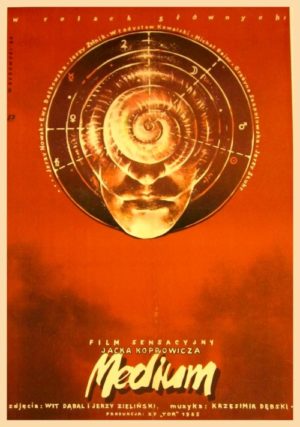
This altogether unique horror thriller was a sizeable hit in its native Poland. Set in the early 1930s, it involves a parapsychologist looking to psychically uncover the presence of a nearby medium, a shadowy individual who makes people do things against their will, after which they immediately lose all memory of those acts. MEDIUM’S success, I’m guessing, was due to its resolutely fast paced, plot driven aesthetic. It’s also extremely well visualized, with an audacious mixture of period drama and psychic horror that was and is unprecedented (the closest match I can think of is THE PRESTIGE). Yet there are problems, including an extremely convoluted narrative and performers who are sorely lacking in charisma (something that isn’t helped at all by the fact that nearly every character is evil and/or emotionally distant). Final thought: MEDIUM is a rare non-American film that could actually stand to be remade by Hollywood, albeit with a streamlined script and more charming leads.
22. PAUL CHEVROLET AND THE ULTIMATE HALLUCINATION (PAUL CHEVROLET EN DE ULTIEME HALLUCINATIE)
In this mindfuck from Holland’s Pim de la Parra (of 1969’s Martin Scorsese scripted OBSESSIONS) a pulp novelist (Peter Faber) finds his reality dissolving after writing a philosophical tract entitled “The Ultimate Hallucination.” Hallucinatory is indeed the word for his present state, in which a mob boss character (Eddie Constantine) from his fiction begins unexpectedly turning up in the here-and-now. Are these intrusions “real” or merely dramatizations of a novel Faber is currently writing? Both possibilities are broached but neither is confirmed in a film that only grows increasingly strange and unfathomable as it advances, freely juxtaposing documentary reality (in rambling scenes of the protagonist wandering around Amsterdam) and pulpy fantasy. That explains why the film never got much play here in America (or much of anywhere else), but it does exert a cockeyed fascination, at least for those viewers willing to surrender themselves to its consistently odd rhythms—however, the extremely unevocative monochrome black and white photography (apparently somebody’s idea of film noir visuals) does make doing so a mite difficult.
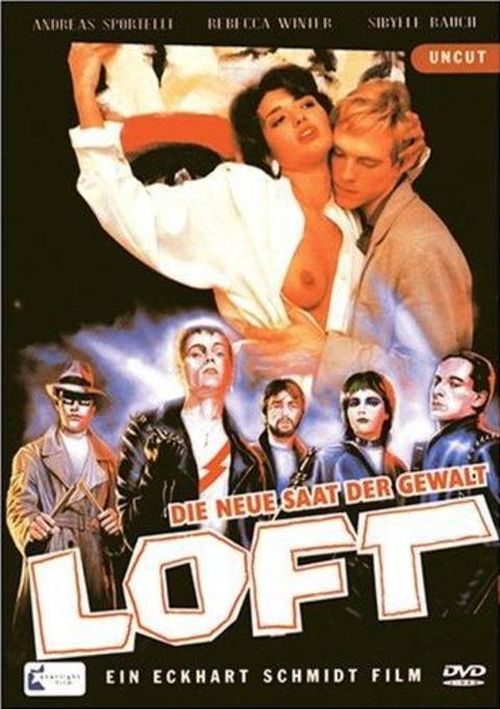 21. LOFT
21. LOFT
Germany’s Eckhart Schmidt was the director of this sci fi-tinged gore fest from 1985. Like Schmidt’s earlier film DER FAN/TRANCE, LOFT is steeped in 1980s new wave culture, which can be seen as a good or bad thing depending on one’s point of view. The film takes place over the course of a single night in a studio apartment, where an art show is being held, and a cast of wealthy assholes and oversexed twentysomethings mix it up in a gory free-for-all that few survive—and from which even fewer emerge unbloodied. Such is LOFT, whose futuristic angle (it allegedly takes place in a post-nuclear world) seems rather pointless. The film was clearly intended as a cockeyed portrait of Germany at the time of its making, evident in the quintessentially eighties-centric look—multi-hued neon illumination, smoke-filled interiors, dramatic backlighting—which is matched by a highly discordant electronic score that back in ‘85 might have passed for avant-garde. It’s fun for eighties nostalgicists with a taste for the extreme (which explains why I enjoyed LOFT despite its shortcomings), but is likely to leave everyone else feeling unfulfilled.
20. SEDUCTION: THE CRUEL WOMAN (VERFUHRUNG: DIE GRAUSAME FRAU)
A heavily stylized German reverie about a dominatrix named Wanda (Mechthild Großmann) and her wacky clientele. Udo Kier plays a client she tortures unmercifully after he makes the mistake of falling in love with her. There’s also a lady who works in a shoe store to satisfy her high heel fetish and a meek American emigrant who with Wanda’s help uncovers her inner sadist. The film, co-directed by lesbian icon Monica Truet (MY FATHER IS COMING), takes these people and their obsessions seriously, never lapsing into comedy. If anything, it may be a bit too heavy handed in its approach, although it has some wicked imagery, most notably in a surreal bit in which Kier views the American gal in action through a flaming doorway.
19. SHADEY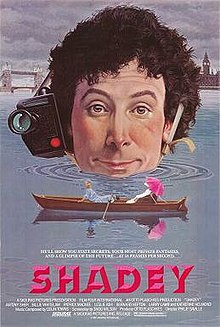
This British free-for-all is something of a self-conscious mess, but won me over with its irresistibly demented vision. Shadey (Antony Sher) is a telepath who can project his thoughts onto film. He signs up to become a spy for the government in order to finance a sex change operation, but there’s trouble when he finds himself doing the thing he least desires: furthering the nation’s military goals. The cloak and dagger stuff is, alas, the least successful part of the film, while Katherine Helmond as Shadey’s nutty mom is easily the best. As she and her son slide further into total dementia the film grows steadily wilder, leading to some truly unpredictable, and grotesque, twists.
18. 90 DAYS
The Canadian made sequel to the previous year’s inexplicably well-received pseudo-documentary THE MASCULINE MYSTIQUE. 90 DAYS follows the former film’s dissatisfied male protagonists, including Stefan Wodoslawsky’s Blue and Sam Grana’s Alex, with the former attempting to settle down with a Korean mail order bride (Christine Pak) and the latter (an insufferable asshole in the previous film who fully retains that status here) becoming a sperm donor. It’s a funny and perceptive little film with some terrific bits of comedy—a surprise visit by Blue’s mother and Alex’s fraught encounter with a male nurse being the stand-outs—and a sense of unshowy realism that far outdoes the intrusive documentary veneer of the previous film.
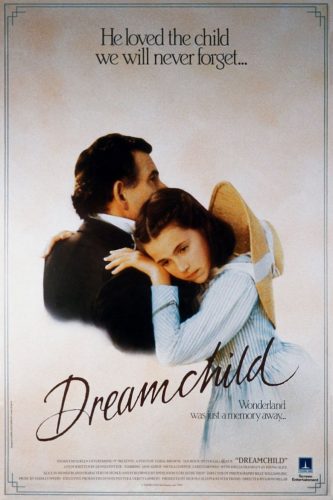 17. DREAMCHILD
17. DREAMCHILD
Definitely a lesser effort from the pen of the great Dennis Potter, but DREAMCHILD got to me. It purports to tell the true story of Alice Hargreaves, the little girl who back in 1865 inspired Lewis Carroll to pen the immortal ALICE IN WONDERLAND. Most of the film is set in 1932, when the ageing Alice (Coral Browne) came to America to accept an honor, and, as portrayed here, thinks back over her unresolved feelings for Carroll (Ian Holm). The flashbacks to the childhood Alice (Amelia Shankley) are copious, and there are also fantasy interludes featuring many of the creatures from ALICE IN WONDERLAND, created by Jim Henson’s company. It never entirely comes together but is undeniably moving nonetheless, with Alice eventually reconciling her love for Carroll in a powerful climax that intercuts the old Alice getting a standing ovation and the young Alice enjoying an outdoor oration by her benefactor.
16. STATIC
A seminal American indie that hardly earth-shattering but has a curious resonance. Keith Gordon, who also co-wrote the script, plays an odd young man working on an invention that supposedly allows for a glimpse of Heaven through a tiny TV monitor. But this “Heaven” looks to me, and everybody else, like plain static, and such a reaction leads Gordon to take some pretty extreme acts. Although sometimes overly cutesy (particularly toward the end), STATIC has a superbly eerie desert setting and admirably measured and precise direction by ONE HOUR PHOTO’S Mark Romanek, while Amanda Plummer delivers one of her best-ever performances as Gordon’s understandably concerned GF.
15. THOU SHALT NOT KILL…EXCEPT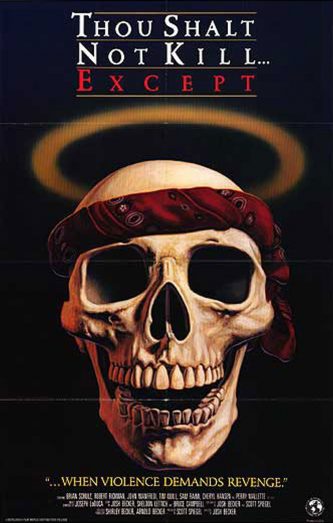
I’ve long gotten a kick out of this no-budgeter from the creators of THE EVIL DEAD. THOU SHALT NOT KILL…’s director Josh Becker and producer/co-writer Scott Spiegel both worked on the former film, while its helmer Sam Raimi plays the antagonist. He’s a Charles Manson-esque cult leader who massacres several people in a Michigan forest, upsetting a band of Vietnam vets who elect to take on him and his minions. The film is let down appreciably by its painfully low budget, but the last twenty or so minutes are a blast: mass shootings, stabbings and impalements are the order of the day in an exhilarating display of unfettered excess.
14. CONTACT
Another tough exercise in ultra-minimalism by the late British TV whiz Alan Clarke, who here provides a slight but resonant hour-long depiction of British troops on patrol in Northern Ireland. As he would in 1989’s ELEPHANT, Clarke dispenses with political sloganeering in favor of a succession of lengthy tracking shots following various folk through a deceptively scenic landscape; of course, those folk are nearly all dressed in military fatigues and firing machine guns. As in Clarke’s best work, it’s the minimalism that really gives CONTACT its edge. We never learn much about any of the soldiers we follow, nor what their objective might be, which sounds like a recipe for disaster but in Clarke’s capable hands makes for riveting viewing, bolstered by some truly shocking violence and an overpowering atmosphere of unsparing realism.
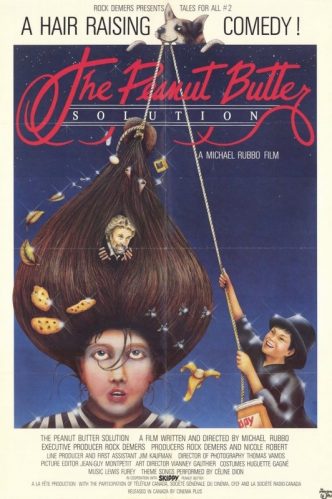 13. THE PEANUT BUTTER SOLUTION
13. THE PEANUT BUTTER SOLUTION
As far as eighties kid movies go this Canadian trifle is about average (i.e. better than MASTERS OF THE UNIVERSE but not nearly as strong as TIME BANDITS), yet gets extra points due to a wholly unique and imaginative narrative. Of course it’s not executed particularly well, with semi-competent performances and oft-clumsy storytelling (complete with characters talking out loud to themselves to fill us in on certain plot points). It’s about a young boy (Matthew Mackay) who after experiencing a fright in a haunted house loses all his hair. A pair of ghosts turn up and instruct the kid on how to whip up a potion that when rubbed on his head will make the hair grow back; this Mackay does, but finds his hair growing back at a horrifically accelerated clip. Where the film goes from there I won’t reveal, but will say that it branches off in some wonderfully odd and unpredictable directions.
12. SUGARBABY (ZUCKERBABY)
A signature film by Germany’s Percy Adlon, with a visual style and outlook that are totally unique. It was constructed around his muse Marianne Sägebrecht (the headliner of the later Adlon films BAGDAD CAFÉ and ROSALIE GOES SHOPPING), who’s tasked with playing an obese nurse who develops a mad crush on a married subway conductor. She takes to stalking the guy, who she dubs “Sugarbaby” after the similarly named pop song, via a Sherlock Holmes worthy investigation into the details of his profession and work hours, and dresses up in suitably slutty fashion to win his heart (and loins). All this is great, and bathed in stunningly gaudy multi-hued primary colors; unfortunately, though, once Sägebrecht nabs her guy around the halfway point most of the inspiration comes to a halt, and the film meanders to an uninspiring finish. Adlon’s highly individualistic film sense, at least, remains constant throughout, so the film’s second half isn’t a total loss.
11. TROUBLE IN MIND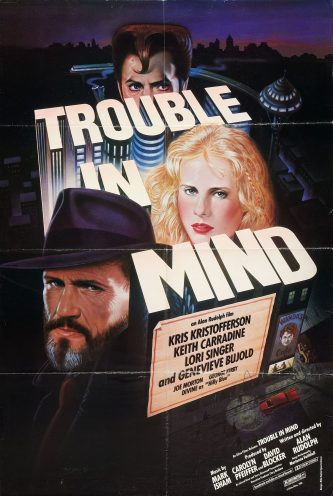
A jazzy mood piece by writer-director Alan Rudolph that mixes romance, film noir and (possibly) sci fi. The setting is a noirish netherworld called Rain City (actually Seattle) where the fates of three characters—Kris Kristofferson as a hard-boiled ex-cop, Keith Carradine as a punked-out hood and Lori Singer as the latter’s alluring wife—converge. There’s little in the way of a narrative, just a series of highly quirky and sometimes violent romantic encounters (with Joe Morton, Dirk Blocker and Divine adding welcome support). It’s enhanced by Rudolph’s confident and stylish helming, which holds one’s attention even in the film’s most monotonous and/or pretentious moments.
10. GRAFFITI
Several films have been adapted from Julio Cortazar’s dystopian parable “Graffiti” (YouTube is currently littered with ‘em), but in my view this Academy Award nominated short is the best by far. A rich and inventive 28 minute feat related entirely without dialogue, GRAFFITI was directed and co-scripted by Matthew Patrick, of the Gary Busey thriller HIDER IN THE HOUSE and the criminally neglected cult film ATRAPADOS. E.J. Castillo plays a young man living in some futuristic locale ruled by a fascistic dictatorship. The young man strikes back at his oppressors via politically-minded graffiti, but is startled by the intrusion of a rival graffiti artist, a young woman (Ivy Broya) who makes whimsical additions to his drawings. The two commence an eccentric romance conveyed entirely through graffiti, which comes to an abrupt end when the woman is caught in the act and dragged off by the authorities. Throughout, Patrick strikes a good balance between oppression and romantic whimsy, and does without an ounce of self-consciousness or pretention. There’s even a happy ending of sorts.
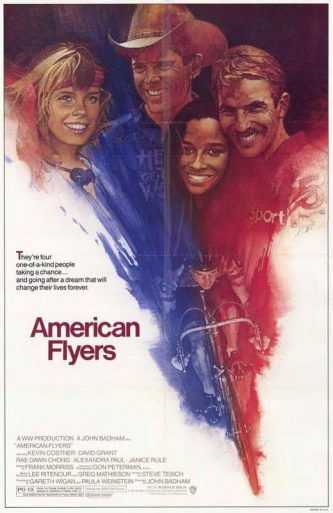 9. AMERICAN FLYERS
9. AMERICAN FLYERS
Cut me some slack, please: I have a weakness for eighties sports movies, and also John Badham flicks from that decade (the interminable SHORT CIRCUIT excepted), and AMERICAN FLYERS happens to be both. A surprise box office flop, the film is an unashamed cliché-fest that essentially does for bike racing what SATURDAY NIGHT FEVER did for disco. It stars a pre-stardom Kevin Costner and David Grant as sibling bicycle enthusiasts who enter the Colorado-based Hell of the West race, competing against a Soviet guy and a slimy American. Yes, that about sums up the plot, which explains why the film’s first half is taken up with plodding family drama involving the bros’ mother (Janice Rule) and deceased father, interspaced with a lot of McDonald’s plugs (an odd choice in a film that assiduously promotes physical fitness). Yet once the Hell of the West gets going the proceedings come to life in a major way. The expertly wrought staging of the race simply cannot be faulted, and, in place of the crummy pop tunes that were popular at the time, is accompanied by a rousing (and quintessentially eighties) score. Badham also deserves points for providing a rich supporting cast, among them Rae Dawn Chong as Costner’s GF, Doi Johnson as a rotund fellow who’s looking to become the first black bowling star, and a pre-DIRTY DANCING Jennifer Grey in a memorably hysterical cameo.
8. L’AMOUR BRAQUE
Another disorienting Andrzej Zulawski freak-out. With its glitzy mayhem and candy-colored cinematography, L’AMOUR BRAQUE appears to have been Zulawski’s answer to the flashy Parisian thrillers of Jean-Jacques Beineix and Luc Besson. Ultimately, though, it’s pure Zulawski through and through, containing all his trademarks: ultra-kinetic camerawork, frenzied performances and an overall air of uncontained hysteria. Allegedly based on Dostoevsky’s THE IDIOT, it’s about a naïve criminal (Francis Huster) who falls in love with a sexy young woman (Sophie Marceau) who happens to be the lover of a vicious gangster (Tcheky Karyo). This crazed love triangle proceeds in a series of unspeakably outrageous set pieces marked by spastic dancing, drug taking, wholesale brutality and perverse sexuality. The proceedings often feel like a disjointed succession of unfettered craziness, yet, as in all of Zulawski’s best work, the film has a definite kinetic grace.
7. SCORPIO NIGHTS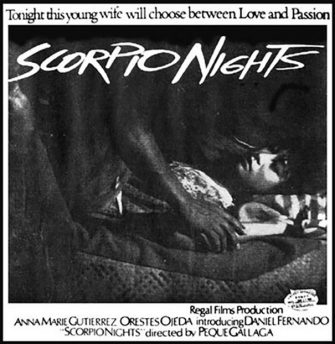
In its day this Filipino erotic drama was apparently quite controversial, but it’s now viewed as the gold standard for cinematic eroticism in Southeast Asia. Western filmmakers would likewise do well to study SCORPIO NIGHTS, as it handily outdoes most attempts at similarly themed cinema (such as 9½ WEEKS and DAMAGE) emerging from our neck of the woods. The subject is a torrid love affair undertaken by a randy young man (Daniel Fernando) living in a Manila townhouse and the luscious woman (Anna Marie Gutierrez) residing below him. Both are married, she to a security guard whose job ensures that he’s away for several hours each day, thus allowing for plenty of amorous activity on the part of our insatiable lovers, and I do mean plenty: nearly two thirds of the film’s runtime is taken up with soft-core sex, which is genuinely erotic and artfully rendered, with the characters’ yearnings and desires boldly expressed through all the shtupping. There are moments of startling perversity, as when Gutierrez surreptitiously masturbates Fernando while advising his wife on an outfit she’s trying on, and a vividly rendered depiction of Filipino slum life, where dozens of people are forced to live in extremely tight quarters and privacy is all-but nonexistent. This of course adds a tinge of real danger to the proceedings, and a dark edge that all-but explodes in the shocking finale, which closes things out on a profoundly bleak but appropriate, and even somewhat moral, note.
6. A ZED & TWO NOUGHTS
Weird doesn’t begin to describe this dark, creepy yet disarmingly cerebral art film by England’s one and only Peter Greenaway. With its gorgeous photography and overwhelming obsession with death and decay, it’s one of my favorite Greenaway films (right up there with THE FALLS and THE COOK, THE THIEF, HIS WIFE AND HER LOVER). The story concerns twin doctors (Brian and Eric Deacon) losing their minds after a car accident outside a zoo leaves their wives dead; they cope by initiating an affair with the woman (Andréa Ferréol) who caused the accident and time lapse photographing dead animals they procure from the zoo. A simple plot summary cannot begin to convey the depths of strangeness mined by A ZED AND TWO NOUGHTS, which is chock full of unfathomable symbolism, long-winded philosophizing, mordantly comic interludes, grotesque imagery and great music by Michael Nyman. In short, it’s like nothing else.
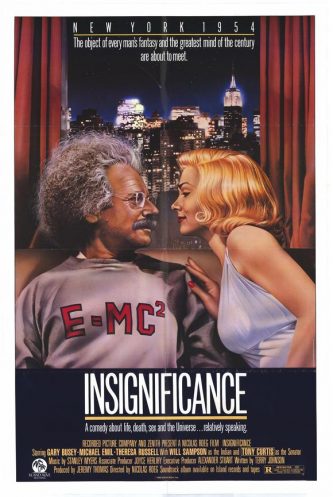 5. INSIGNIFICANCE
5. INSIGNIFICANCE
The promo art for this film makes it out to be a brainy comedy, but it’s actually a far richer concoction: a deeply fascinating and disquieting meditation on time and memory that’s very much in the mode of director Nicolas Roeg’s previous films PERFORMANCE and BAD TIMING. Set in the 1950s-era NYC, it imagines a night when Theresa Russell as “The Actress” (Marilyn Monroe) teaches Michael Emil as “The Professor” (Albert Einstein) the theory of relativity, much to the consternation of Gary Busey as “The Ballplayer” (Joe DiMaggio) and Tony Curtis as “The Senator” (Joe McCarthy). Taking place almost entirely in The Professor’s hotel room, it’s very talky, yet decked out with quintessentially Roegian flashbacks and fantasy sequences which culminate in an apocalyptic conflagration that leaves nobody unscathed.
4. FORTRESS
This Aussie thriller, adapted from a novel by Gabrielle Lord, was one of the first movies to be released straight to HBO (a then-unprecedented move). It starts with four masked gunmen kidnapping teacher Rachel Ward and her students from a rural one-room schoolhouse, precipitating a breakneck jaunt through the outback involving confinement, escape and some truly impacting violence. This is action moviemaking done right: it’s fast and mean, with character details sketched cleanly and efficiently. Nor does director Arch Nicholson shy away from the nasty stuff, particularly in the final scenes, when Ward and the kids decide to fight back against their attackers. Even as we root for the Good Guys to get back at their adversaries, we’re never allowed to forget that these are little kids being forced into a violent adult word from which there’s no way back. The ending is particularly unsettling, with a final image I’ve never forgotten.
3. BLISS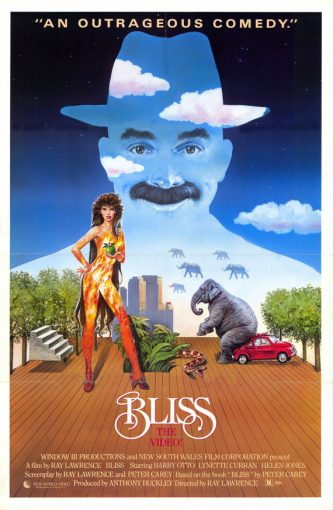
More madness from Down Under, a film whose opening thirty minutes are hard to beat for artful lunacy. A man (Barry Otto) has a heart attack and finds himself in purgatory, an irrational realm where his wife (Lynette Curran) bangs his best friend in a crowded restaurant and then has tiny fish fall out of her vagina, his daughter fellates her brother (who wears a Nazi suit), rampaging elephants crush his car and cockroaches swarm from his stitched-up chest. Sustaining such sublime derangement would be difficult, so it’s no surprise that the remainder of the film is a bit of a let-down. But director Ray Lawrence refuses to give up, and pulls off some striking images (such as little kids being hauled off to death camps) and a curiously moving rainforest set finale.
2. CRIME WAVE (THE BIG CRIMEWAVE)
A seminal Canadian cult film that still holds up. Imagine a Zucker brothers satire directed by David Lynch and you’ll have some idea of the unbelievable oddness of CRIME WAVE, which is nonetheless extremely endearing in its way. It’s also one of the most sheerly inventive films I know of, with a plethora of low budget ingenuity and an assured visual style that apes 1950s kitsch. It centers on a nutty screenwriter (played by the film’s writer-producer-director John Paizs) attempting to write the world’s greatest “color-crime movie.” The problem is that he only writes the beginning and ending of the film, leaving the rest blank. Thus we see several beginnings and endings enacted, all involving unhinged characters attaining unbelievable success only to eventually lose it all. Not all of it works—a bit involving a car driving dog falls flat, and I’m not sure how I feel about the ending in which Paizs becomes some kind of super hero—but it’s such a gloriously insane and adroitly realized concoction that I won’t complain overmuch.
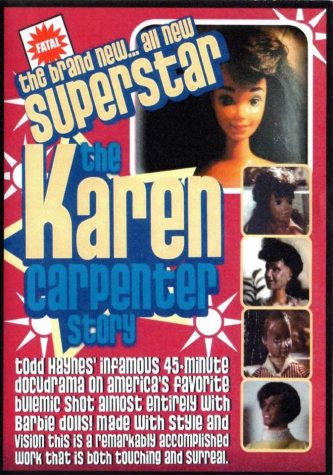 1. SUPERSTAR: THE KAREN CARPENTER STORY
1. SUPERSTAR: THE KAREN CARPENTER STORY
This 43-minute film explores the life of the late Karen Carpenter through Barbie Dolls. Barbie Doll movies aren’t entirely uncommon in the American underground sphere (see DOLLA MORTE, COOL KIDS’ HIGH and the seventies-era shorts of Tina L’Hotsky), but this is easily the most accomplished such effort. For that matter, it may well be the masterpiece of director Todd Haynes, who’s created a film that falls somewhere between a serious inquiry into the horrors of anorexia (complete with “educational” interludes filling us in on the particulars of the disease) and a perverted exploitation drama. We see Karen C. go from a bright-eyed young Barbie concerned about her weight to an unstable pop star with a spanking fixation as the film itself becomes an increasingly dark and unsettling psychofest. The soundtrack is papered with Carpenter tunes that were used without permission, resulting in SUPERSTAR being pulled from circulation (and becoming a greymarket sensation). However you manage to view it, SUPERSTAR is a great movie.
